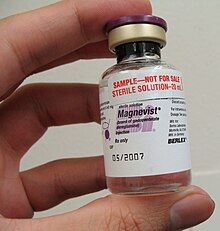Gadopentetic acid
 | |
| Clinical data | |
|---|---|
| Trade names | Magnevist |
| Other names | gadopentetate dimeglumine (USAN US) |
| AHFS/Drugs.com | Consumer Drug Information |
| Routes of administration | Intravenous |
| ATC code | |
| Legal status | |
| Legal status | |
| Pharmacokinetic data | |
| Elimination half-life | Distribution half-life 12 minutes, elimination half-life 100 minutes |
| Identifiers | |
| CAS Number | |
| PubChem CID | |
| DrugBank | |
| ChemSpider | |
| UNII | |
| KEGG | |
| ChEBI | |
| ChEMBL | |
| CompTox Dashboard (EPA) | |
| Chemical and physical data | |
| Formula | C14H18GdN3O10 |
| Molar mass | 545.56 g·mol−1 |
| 3D model (JSmol) | |
| |
| |
| | |
Gadopentetic acid, sold under the brand name Magnevist, is a gadolinium-based MRI contrast agent.[2]
It is usually administered as a salt of a complex of gadolinium with DTPA (diethylenetriaminepentacetate) with the chemical formula A2[Gd(DTPA)(H2O)]; when cation A is the protonated form of the amino sugar meglumine the salt goes under the name "gadopentetate dimeglumine". It was described in 1981 by Hanns-Joachim Weinmann and colleagues[4] and introduced as the first MRI contrast agent in 1987 by the Schering AG. It is used to assist imaging of blood vessels and of inflamed or diseased tissue where the blood vessels become "leaky". It is often used when viewing intracranial lesions with abnormal vascularity or abnormalities in the blood–brain barrier. It is usually injected intravenously. Gd-DTPA is classed as an acyclic, ionic gadolinium contrast medium. Its paramagnetic property reduces the T1 relaxation time (and to some extent the T2 and T2* relaxation times) in NMR, which is the source of its clinical utility.

Gadolinium based agents may cause a toxic reaction known as nephrogenic systemic fibrosis (NSF) in patients with severe kidney problems.[5][6]
Compared to other gadolinium-based MRI contrast agents, Gadopentetate dimeglumine (Gd-DTPA2-) chelates allow delayed Gadolinium-enhanced Magnetic Resonance of Cartilage (dGEMRIC). The unique charge characteristic of this complex allows researchers to inversely measure spin-lattice relaxation times as they are related to the concentration of proteoglycan aggregates and charged glycosaminoglycan side chains in articular cartilage.[7][8]
Chemical structure and mode of action
In the complex of Gd3+ and DTPA5− the gadolinium ion is 9-coordinate, surrounded by the 3 nitrogen atoms and 5 oxygen atoms from the carboxylate groups. The ninth coordination site is occupied by a water molecule.Sherry AD, Caravan P, Lenkinski RE (December 2009). "Primer on gadolinium chemistry". Journal of Magnetic Resonance Imaging. 30 (6): 1240–1248. doi:10.1002/jmri.21966. PMC 2853020. PMID 19938036. This water molecule is labile and exchanges rapidly with water molecules in the immediate vicinity of the gadolinium complex. The gadolinium ion has 7 unpaired electrons with parallel spins and is strongly paramagnetic with an 8S electronic ground state. The relaxation time of the water molecules is affected by their intermittent binding to the paramagnetic centre. This alters their MRI properties and enables contrast enhancement to be achieved.[9]
Concerns
Gadolinium is highly toxic and the accumulation of gadolinium in the brain has become a concern. The EU banned linear chelates in 2017.[10][11]
References
- ^ "Product monograph brand safety updates". Health Canada. 7 July 2016. Retrieved 13 July 2024.
- ^ a b "Magnevist- gadopentetate dimeglumine injection". DailyMed. Retrieved 29 August 2021.
- ^ "List of nationally authorised medicinal products: Gadopentetic acid" (PDF). Europeans Medicines Agency. 14 January 2021.
- ^ US 5021236, "Method of enhancing NMR imaging using chelated paramagnetic ions bound to biomolecules"
- ^ Murphy KJ, Brunberg JA, Cohan RH (October 1996). "Adverse reactions to gadolinium contrast media: a review of 36 cases". AJR. American Journal of Roentgenology. 167 (4): 847–849. doi:10.2214/ajr.167.4.8819369. PMID 8819369.
- ^ Thomsen HS, Morcos SK, Dawson P (November 2006). "Is there a causal relation between the administration of gadolinium based contrast media and the development of nephrogenic systemic fibrosis (NSF)?". Clinical Radiology. 61 (11): 905–906. doi:10.1016/j.crad.2006.09.003. PMID 17018301.
- ^ Bashir A, Gray ML, Boutin RD, Burstein D (November 1997). "Glycosaminoglycan in articular cartilage: in vivo assessment with delayed Gd(DTPA)(2-)-enhanced MR imaging". Radiology. 205 (2): 551–558. doi:10.1148/radiology.205.2.9356644. PMID 9356644.
- ^ Bashir A, Gray ML, Hartke J, Burstein D (May 1999). "Nondestructive imaging of human cartilage glycosaminoglycan concentration by MRI". Magnetic Resonance in Medicine. 41 (5): 857–865. doi:10.1002/(sici)1522-2594(199905)41:5<857::aid-mrm1>3.0.co;2-e. PMID 10332865. S2CID 22939233.
- ^ Caravan P, Ellison JJ, McMurry TJ, Lauffer RB (September 1999). "Gadolinium(III) Chelates as MRI Contrast Agents: Structure, Dynamics, and Applications". Chemical Reviews. 99 (9): 2293–2352. doi:10.1021/cr980440x. PMID 11749483.
- ^ "Gadolinium-containing contrast agents: removal of Omniscan and iv Magnevist, restrictions to the use of other linear agents". GOV.UK. 14 December 2017. Retrieved 29 August 2021.
- ^ "EU pulls gadolinium contrast agents over deposition concerns". www.radiologybusiness.com. Retrieved 18 August 2020.
